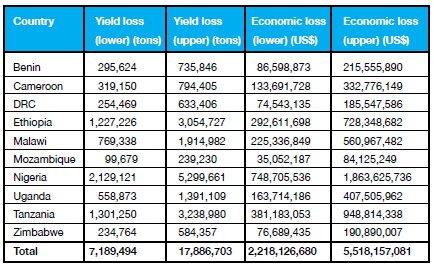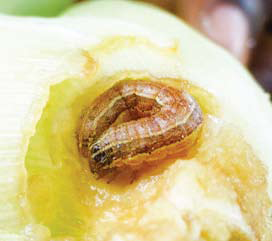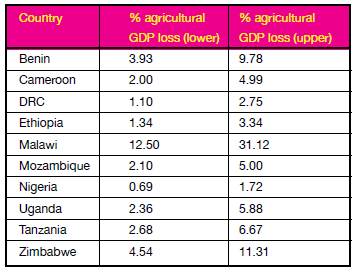Fall Armyworm Status: Impacts and control options in Africa
 In the first evidence note (Fall Armyworm Status: Impacts and control options in Africa, Preliminary Evidence Note) written by CABI in April 2017, 17 countries confirmed FAW presence through official and unofficial sources. Nine more were suspected of having the pest. As this report shows however, the situation is constantly evolving.
In the first evidence note (Fall Armyworm Status: Impacts and control options in Africa, Preliminary Evidence Note) written by CABI in April 2017, 17 countries confirmed FAW presence through official and unofficial sources. Nine more were suspected of having the pest. As this report shows however, the situation is constantly evolving.
At the time of going to press, FAW had been reported from 28 countries. These include a variety of sources including IPPC reports, ministerial declarations, peer reviewed journals, and UN affiliated organisation reports. A further nine countries have conducted or are presently conducting surveys, and either strongly suspect its presence or are awaiting official confirmation, at the time of publication. Two countries have stated that FAW is absent from the country.
The FAW is now well distributed across the African continent and national reports on the status in many countries have been published. However, the content of information in the reports is very variable, which makes wider estimates of FAW impacts on maize yield and economics at a national level based on these sources difficult.
Economic impact
Thus, to estimate the potential impacts on yield and economics on the major maize producing countries that is likely to happen over the next few maize producing seasons assuming that the FAW will spread throughout all areas where it is predicted to survive, CABI has estimated impacts of FAW for 10 substantial maize producing countries by extrapolating estimates of proportion of yield loss derived from a survey from Ghana and Zambia and combining this with published data on national maize production and other information for the 10 countries. The total estimated yield and economic losses for each of the 10 countries are given in Table 1, below.

On this basis it can be seen that currently Benin, Malawi and Zimbabwe are most affected.
The estimates indicate that for these 10 countries taken together, the potential impact of FAW on maize yield lies between 7.2 and 17.9m tonnes per year and with losses lying between $2,218m and $5,518m per year. The economic losses have also been expressed as (lower and upper) percentage loss to agricultural GDP (averaged over the last three years) in Table 2, below.
Control options
In the Americas pesticides and genetically modified (GM) crops are the main methods of control, although FAW has developed some resistance to both. Most countries in Africa do not yet plant GM crops.
Pesticides are an option in Africa, though are not always affordable to many small-scale farmers; subsidy or government-funded implementation is therefore being used in some countries.
Lower-cost mechanical and cultural control methods have yet to be proven in Africa, but could be adopted in the meantime.
Mass rearing and release of parasitoids and predators is used as an alternative in the Americas but currently costs may be prohibitive without subsidy in Africa.
Classical (introduction) biological control should be pursued immediately. Virus-based biopesticides available in the Americas may offer a low-risk option, but are not yet registered in Africa, and again may be expensive for many farmers. In all cases a widespread communications programme is necessary to inform farmers how to monitor and identify the pest, and what management methods are available which can be selected according to local context.
In this, any direct control methods target the larvae, but two aspects of the biology pose constraints:
• Larvae are relatively inactive during the day, so treatment (e.g. spraying) is best done in the early or late part of the day
• Older larvae tend to bore into the whorl or cob (of maize), so contact pesticides are not effective unless applied when the larvae are young. Monitoring is required to detect the young larvae, and to determine whether treatment is justified.
 Monitoring for treatment decision making
Monitoring for treatment decision making
Two approaches to monitoring are used, both of which need further investigation in Africa:
Trapping adults: Pheromone traps attract the male moths with a synthetic sex pheromone, and give an indication of the adult population in an area. Scouting: Plants are inspected in detail, and different aspects of the damage and/or the presence or number of eggs and different sizes of larvae recorded. Different scouting protocols may be used for different crops, and times of the season. Based on the results of monitoring, a decision whether to treat can be made.
Pesticide registrations and recommendations
To be legally used for FAW control, a pesticide must be registered, requiring efficacy and toxicity data. Large numbers of pesticides are registered in the Americas; Brazil has around 40 products registered for Fall Armyworm. In the USA each state makes its own recommendations, usually by crop. However, in the Americas, resistance has developed to some types of pesticide; the risk of this can be reduced by rotating pesticides with different types of action.
In Africa registration processes exist, but can be lengthy. No pesticides are fully registered for FAW yet; in some cases emergency registration is possible. Much un-registered (and therefore technically illegal) pesticide use is occurring.
Immediate actions
Farmers need advice on what actions they can take immediately. The following are suggested, though not all are supported by evidence, and they should be adjusted when more evidence is available on alternatives to pesticides and how agronomic practices can reduce risk/damage.
• Monitor susceptible crops at least weekly, with the aim of detecting egg masses and/or young larvae. Large scale farms could consider using pheromone traps for monitoring but visual inspection is also advised.
• On detecting FAW or early damage (windowing of leaves) consider treatment:
• Small farms, depending on resource availability: Handpicking; placing sand/soil mixed with ash/lime into the whorl; pesticide application. Give priority to damaged plants but treat whole field if possible.
• Large farms: Pesticide application to affected fields o Pesticides: Use WHO Class 3 or U if possible (though lower risk products tend to be more expensive), from a nationally recommended list. Use personal protective equipment and follow manufacturer’s instructions.
• After treatment, continue monitoring, and consider further treatment if more young larvae appear. Continue until plants become too large to monitor/treat.
It is suggested that national authorities undertake the following steps as far as possible:
• Promote awareness of FAW, its identification, damage and control
• In consultation with agro-input suppliers, prepare and communicate a list of recommended pesticides. The pesticides should be available, and preferably already registered for the crop in which they are to be used, and/or for use on other caterpillars. Pesticides registered/recommended for FAW control in the Americas could be selected, but WHO class 1a or 1b pesticides should never be recommended (recommendations in US are for very specific uses).
• Provide emergency/temporary registration for the recommended pesticides. Registrants should provide supporting data from the Americas within a specified period.
• Arrange for laboratory efficacy tests of recommended pesticides to be conducted by authorised national laboratories.
• Regularly review recommendations and publicise changes promptly and widely.
• Consider short term subsidies for small scale farmers, for example to reduce prices for lower risk product.
A comprehensive range of actions for the short, medium and long term was identified at an international meeting organised by AGRA, FAO and CIMMYT in Nairobi in April 2017. This has subsequently been developed by FAO and partners into a framework containing 4 components:
1. FAW Management, including early warning and control methods
2. Assessment of the impact of the pest
3. Communication, information sharing and awareness raising
4. Coordination. The Nairobi meeting agreed that FAO should be responsible for overall coordination.
FAO will be publishing the final version of the framework in September, which will provide a guide for development of projects and programmes by the various stakeholders.
